-
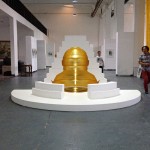
-
Exposition septembre 2013 « Dialogue – Retour en Chine » Akade in Left Right International art Zone of Fuhao. Songzhuang. Beijing. Curator Tian Ye. Sculpture produite par la fondation d’entreprise Hermès.
-

-
Exposition septembre 2013 « Dialogue – Retour en Chine » Akade in Left Right International art Zone of Fuhao. Songzhuang. Beijing. Curator Tian Ye
-

-
Akade produit par la fondation d’entreprise Hermès
-
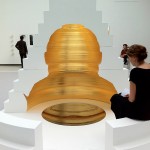
-
Akade produit par la fondation d’entreprise Hermès
-

-
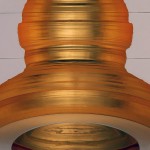
-
Akade 2011 produit par la Fondation d’Entreprise Hermès. Exposition personnelle La Verrière. Bruxelles. Sculpture diamètre 2.60m. Hauteur 2 m. Socle 4.60 m x 2.30 m.
Matériau composite et enduit époxy blanc. Dorure à la feuille.
Miroir en acier inoxydable, diamètre 1.20 m.
-
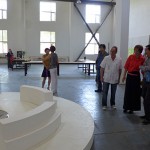
-
Akade.
Exposition personnelle Left Right International. Art Zone. North of Fuhao. Songzhuang. Beijing. Curator Tian Ye. Vernissage le 15 septembre 2013. Beijing
-
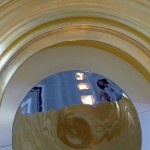
-
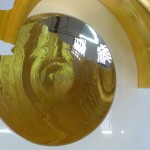
-

AK-A-DE
Un artiste français qui devait exposer au Mexique des dessins du volcan Popocatépetl embarque sur le vol Mérida-Mexico. C’était en février 2005. Dans l’avion, il décrit à sa voisine ses autres travaux : les sténopés, photos uniques obtenues par une camera obscura et par impression directe ; des images de Ceiba, ou fromagers, arbres qui se propagent, considérés comme des piliers célestes, vénérés par les Mayas, et de cenotes, sortes de grottes naturelles à ciel ouvert, parfois ornées, elles aussi sacrées. Dans l’avion, un autre voyageur, Laurent Chabres, négociant en fruits et légumes, collectionneur d’art et président de la Fondation Bienestar, entend la conversation. Quelques jours plus tard, un de ses amis, Alfredo Cruz, commissaire d’exposition, lui recommande l’artiste Jean-Charles Pigeau, qui parcourt le Mexique depuis plus de vingt-cinq ans. Laurent Chabres se souvient du récit intercepté en vol et le reçoit aussitôt dans son hacienda. Se noue à partir de là une belle amitié, suivie de commandes importantes de ce mécène mexicain. Notamment L’Oratoire, une extraordinaire sculpture/architecture monumentale en ciment blanc, réalisée à Baca, dans le Yucatan, inaugurée en août 2009. Dans un petit livre sur Jean-Charles Pigeau, Éloge de la traversée, le critique Philippe Piguet parle de la fascination de l’artiste pour le plâtre : « Le plâtre prend le temps : il le retient dans sa masse et ne le lâche plus. Il fait corps avec ce qu’il insère et les formes qu’il prend sont toujours celles d’un temps figé. »
Artiste idéaliste, nomade, infatigable marcheur, aventurier, voire risque-tout, Jean-Charles Pigeau, avant-dernier d’une fratrie de onze enfants élevés en terre de Beauce, avance sans peur sur tous les continents depuis les rencontres internationales de Montréal en 1977, jusqu’à Kyoto (le temple aux mille et un bouddhas) et l’île de Nahoshima, au large d’Okayama, et Xi’an, en Chine, en 2010, en passant par Montrouge, la Fondation d’Art Contemporain Daniel et Florence Guerlain aux Mesnuls, le centre d’art du Crestet, Göteborg, en Suède, le Centre culturel Tjibaou en Nouvelle-Calédonie, New York, ou Bayside, au Nouveau-Brunswick (Canada). Au Mexique, il a exposé plus de vingt fois. Comme le fameux collectionneur et expert en arts premiers Jacques Kerchache, il se passionne pour l’art olmèque, matrice de l’art préhispanique (1300-800 avant J.-C.). « La qualité des objets chez les Olmèques, explique-t-il, le choix de leurs matériaux et leur économie de moyens pour transmettre une pensée, un concept, en font de très grands sculpteurs. Chez eux l’œuvre ne représente pas, elle signifie. » En 2008, il a collaboré avec la Manufacture nationale de Sèvres, et réalisé Cratère, petite sculpture-paysage en biscuit et or, née de ses fréquentes visites au Popocatépetl, dont elle reprend fidèlement la coupe.
Et il rêve d’installer, dans un temple de Kyoto, Pluie céleste, un champ de mille javelots de deux mètres soixante-dix de haut en aluminium poli brillant, fichés en pleine terre ! Comme toujours, chez Jean-Charles Pigeau, le travail artistique procède d’une longue et patiente quête herméneutique. Précédée de voyages de repérage et d’études approfondies. Les moines du temple de Kyoto, eux, sont déjà venus voir de quoi il en retourne dans l’atelier de la rue de Bagnolet, à Paris. Aucune inquiétude, le projet finira par se faire. Ainsi, quelques exemples de sa détermination. En 1992, pour pouvoir trouver un espace du Mexique vierge de toute trace d’actualité, Pigeau avait parcouru des kilomètres et avait fini par jeter son dévolu sur Sayula, dans l’État de Jalisco, où un lac s’évaporait chaque été. Revenu là un an plus tard, avec Suite pour ciel seul ; sept sculptures-miroirs paraboliques, il avait vu, stupéfait, surgir du sol des cercles de même diamètre au fond du lac à la terre toute craquelée : les Indiens y faisaient jadis sécher le sel (entre 600 et 900 de notre ère). Six ans plus tard, premier artiste contemporain à investir un site préhispanique, il installe Les Conques devant la pyramide dédiée au dieu du Vent Ehecatl. Le projet (organisé par le Getty Conservation Institute) s’est prolongé ensuite à Nouméa, où Pigeau s’est établi de longues semaines pour saisir le vent dans les frondaisons du chemin kanak et le traduire en sténopéphotographies. Il y a même appris à « siffler pour faire venir le vent ». Autre rituel, autre aventure, en 1999, grâce à la Fondation d’Art Contemporain Daniel et Florence Guerlain, Pigeau installe Offrandes, neuf éléments de terre crue, sur les flancs du Popocatépetl, puis revient un an plus tard en photographier les vestiges.
À La Verrière, invité par la Fondation d’entreprise Hermès, il construit une cellule de méditation blanche, entièrement doublée à la feuille d’or. Devant elle, sur le sol, un disque-miroir capte le toit vitré, donc le ciel, le petit temple lui-même, et le regard du visiteur. Celui-ci se montre ému par cette sculpture qui parle directement à l’âme. Comme les autres travaux de Jean-Charles Pigeau, elle agrège les notions de sacré, d’universalité, le cycle du temps, l’imprévu. L’humour aussi. Un jour Pigeau moule quelques citrons verts en plâtre pour son mécène mexicain qu´il appelle "le roi du citron". À La Verrière, il les présente, régénérés, tout en or. « Imaginer, disait Gaston Bachelard, c’est hausser le réel d’un ton. »
Alice Morgaine
Directrice artistique de La Verrière
Texte pour le catalogue de l’exposition personnelle de Jean-Charles Pigeau à la Verrière. Bruxelles en septembre/octobre 2011. Fondation d’Entreprise Hermès.
AK-A-DE
Due to exhibit his drawings of the Mexican volcano Popocatepetl, a French artist takes a flight from Merida to Mexico City. It is February 2005. During the flight, he describes his other works to his neighbour: pinholes, unique photographs taken using a camera obscura and by direct impression; images of Ceibas, silk-cotton trees that self-propagate and were venerated by the Mayans as heavenly pillars, and cenotes, a sort of natural cave open to the sky, occasionally decorated and also sacred. The conversation is overheard by another passenger, Laurent Chabres, a fruit and vegetable magnate, art collector and president of the Bienestar Foundation. A few days later, his friend and exhibition curator Alfredo Cruz Ramirez recommends to him the artist Jean-Charles Pigeau, who has been travelling across Mexico for the last twenty-five years. Laurent Chabres recalls the overheard in-flight conversation and loses no time in inviting him to his hacienda. Thus was forged a fruitful friendship, followed by significant commissions from this Mexican art patron. In particular, the Oratoire, an extraordinary piece of sculpture/monumental architecture in plaster (white cement, to be exact), executed in Baca in Yucatan Province, and inaugurated in August 2009. In his short book on Jean-Charles Pigeau, Éloge de la traversée, the critic Philippe Piguet talks of the artist’s fascination for plaster: “Plaster takes time: it retains it within its mass and holds on to it. It is as one with what time imbues in the work, and the forms it takes are always those of a moment fixed in time.”
An idealistic, nomadic artist, tireless walker, adventurer - a daredevel even - and the last-but-one of eleven siblings raised in Beauce, Jean-Charles Pigeau has been fearlessly exploring every continent, from the Rencontres Internationales de Montréal in 1977 to Kyoto (Temple of A Thousand and One Buddhas) and the Island of Nahoshima off the coast of Okayama, Xi’an in China in 2010, and taking in on the way Montrouge, the Fondation d’Art Contemporain Daniel et Florence Guerlain at Les Mesnuls, the Crestet Art Centre, Göteborg in Sweden, the Tjibaou Cultural Centre in New Caledonia, New York and Bayside in New-Brunswick (Canada). He has exhibited in Mexico on over twenty occasions. Like the famous collector and expert on primal arts Jacques Kerchache, he is passionate about Olmec art, the forerunner of pre-Hispanic art (1300-800 BC). “The quality of the artefacts produced by the Olmec,” he explains, “their choice of materials and the economy in the means they employ to convey a thought, a concept, make them extraordinary sculptors. For them, the work is not a representation but a meaning.” In 2008, he collaborated with the Manufacture Nationale de Sèvres, and created Cratère, a small landscape sculpture in biscuit and gold inspired by his frequent visits to Popocatepetl whose cross-section the work accurately reproduces.
And he dreams of installing, in a temple in Kyoto, Pluie céleste (Heavenly Rain), a field of one thousand 2.7m-tall javelins in shiny polished aluminium, inserted straight into the earth! As always, for Jean-Charles Pigeau, artistic work is a process of long and patient hermeneutic quest. Preceded by fact-finding journeys and in-depth studies. The monks of the temple of Kyoto have already visited the Rue de Bagnolet studio in Paris to get a sense of what is in store. No need for concern, the project will be a success. And so to a few examples of his determination. In 1992, in order to find a piece of Mexico untouched by any trace of modernity, Pigeau travelled miles and settled on Sayula, in the State of Jalisco, where a lake evaporated every year. Returning one year later with ten parabolic mirror sculptures, he was astonished to discover circles, all of equal diameter, emerging from the ground on the lake bottom, now a stretch of cracked earth: the Indians dried salt here between 600 and 900 AD. Six years later, as the first contemporary artist to take over a pre-Hispanic site, he installed Les Conques in front of the pyramid dedicated to the Wind God. The project (organised by the Getty Conservation Institute) was later extended to Noumea, where Pigeau installed himself for weeks on end in order to capture the wind in the foliage of the Canak path and translate it into pinhole photographs. Whilst there, he even learned how to “whistle to bring the wind.” Another ritual, another adventure: in 1999, through the Fondation d’Art Contemporain Daniel et Florence Guerlain, Pigeau installed Offrandes, nine elements of raw earth, on the slopes of Popocatapetl, and then returned one year later to photograph what remained.
At the invitation of the Fondation d’entreprise Hermès, he has built at La Verrière a white meditation cell, entirely lined with gold leaf. On the ground in front of it, a mirrored disc captures the glass roof – and hence the sky – the little temple itself and the gaze of the spectator. The latter can be seen to be moved by this sculpture that speaks directly to the soul. Like Jean-Charles Pigeau’s other works, it incorporates notions of the sacred, universality, the cycle of time, the unexpected. Humour too. One day, Pigeau molds a handful of plaster limes for his Mexican sponsor he calls “the lemon King”. He presents these at La Verrière, regenerated, all in gold. “To imagine,” said Gaston Bachelard, “is to raise reality’s pitch one tone.”
Alice Morgaine
Art Director, La Verrière
AKADE
Un artista francés que debía exponer en México unos dibujos del volcán Popocátepetl, se dispone a abordar el vuelo Mérida-Ciudad de México. Es el mes de febrero de 2005. Ya en el avión, comienza a describir a su vecina de asiento sus demás trabajos: las fotografías estenopeicas, es decir, fotografías únicas obtenidas gracias a una camera obscura y mediante impresión directa; son imágenes de Ceibas o árboles del algodón, árboles que se propagan solos, considerados como pilares celestes y venerados por los Mayas, así como de cenotes, especies de grutas naturales a cielo abierto, a veces ornamentadas y también consideradas sagradas. En el avión, otro pasajero, Laurent Chabres, negociante de frutas y legumbres, coleccionista de arte y presidente de la Fundación Bienestar oye sin querer la conversación. Unos días más tarde, un amigo suyo, Alfredo Cruz, que es curador, le recomienda al artista Jean-Charles Pigeau, quien lleva ya más de veinticinco años recorriendo México. Laurent Chabres recuerda entonces aquella charla que tuvo oportunidad de oír durante el vuelo y decide recibir sin tardanza al artista en su hacienda. A partir de ese momento se forja una bella amistad, seguida de importantes pedidos por parte de este mecenas mexicano. Destaca sobre todo El Oratorio, un extraordinario y monumental conjunto escultórico arquitectónico en cemento blanco, realizado en Bacca, Yucatán, e inaugurado en agosto de 2009. En un pequeño libro dedicado a Jean-Charles Pigeau, Elogio de la travesía, el crítico Philippe Piguet habla de la fascinación del artista por el yeso: “El yeso capta al tiempo: lo retiene en su masa y ya no lo suelta. Forma un solo cuerpo con aquello que integra y las formas que adopta son siempre las de un tiempo que se ha quedado fijo”.
Artista idealista, nómada, incansable andariego, aventurero, incluso temerario, Jean-Charles Pigeau, penúltimo de una familia de once hermanos criados en la Beauce, avanza sin miedo por todos los continentes, desde Montreal, con ocasión de los encuentros internacionales de 1977 hasta Kioto (el templo de los mil y un budas) y la isla de Nahoshima, frente a las costas de Okayama; está también presente en Xi’an, en China, en 2010. Entretanto, pasa por Montrouge, por la Fundación de Arte Contemporáneo Daniel y Florence Guerlain en Mesnuls, por el centro de arte del Crestet y por Gotemburgo, en Suecia; expone en el Centro cultural Tjibaou en Nueva-Caledonia, en Nueva York y en Bayside, en Nuevo-Brunswick (Canadá). En México ha expuesto más de veinte veces. Al igual que el famoso coleccionista y experto en arte primitivo Jacques Kerchache, Jean-Charles Pigeau se apasiona por el arte olmeca, matriz del arte prehispánico (1300-800 a.C.). “La calidad de los objetos de los Olmecas, explica Pigeau, la elección de sus materiales y la economía de recursos para transmitir un pensamiento, un concepto, hacen de ellos grandes escultores. Para los Olmecas, la obra no representa, significa.” En 2008, colaboró con la Manufactura nacional de Sèvres y realizó Cráter pequeña escultura-paisaje en porcelana y oro, que nace a raíz de sus frecuentes visitas al Popocatépetl, cuyo contorno reproduce fielmente.
Y sueña con instalar, en un templo de Kioto, Lluvia celeste, un campo de mil jabalinas de 2 m70 de altura realizadas en aluminio pulido brillante y ¡clavadas en plena tierra! Como siempre, en la obra de Jean-Charles Pigeau, el trabajo artístico procede de una larga y paciente búsqueda hermenéutica la cual va precedida de viajes de identificación de sitios y profundos estudios. Los monjes del templo de Kioto, por su parte, ya vinieron a ver cómo van las cosas en el estudio de la calle Bagnolet, en París. Nada de que inquietarse, el proyecto se llevará finalmente a cabo. Estos son algunos ejemplos de su determinación. En 1992, movido por la idea de encontrar un espacio de ese México virgen de cualquier rastro de actualidad, Pigeau había recorrido kilómetros, para finalmente decidirse por Sayula, en el Estado de Jalisco, ahí donde un lago se evaporaba en cada periodo estival. Un año más tarde, al volver de nuevo a aquel lugar, con Suite para cielo solo, siete esculturas-espejos parabólicos, vio con estupefacción cómo surgían unos círculos con el mismo diámetro en el fondo del lago de tierra resquebrajada: en el pasado los indios ponían a secar la sal en ese sitio (entre 600 y 900 de nuestra era). Seis años después, se convertirá en el primer artista contemporáneo en hacer una intervención en un sitio prehispánico con su instalación de Las conchas delante de la pirámide dedicada al dios del viento Ehécatl. El proyecto (organizado por el Getty Conservation Institute) se prolongó más tarde hasta Numea, en donde Pigeau se estableció por largas semanas para captar el viento en las frondas del camino kanak y traducirlo en fotografías estenopeicas. Ahí aprendió incluso a “silbar para hacer venir el viento”. Otro ritual, otra aventura: en 1999, gracias a la Fundación de Arte Contemporáneo Daniel y Florence Guerlain, Pigeau instala Ofrendas, nueve elementos de barro crudo en las faldas del Popocatépetl, a donde regresa un año más tarde para fotografiar los vestigios de la obra.
En La Verrière, invitado por la Fundación Hermès, construye una capilla de meditación en color blanco, totalmente recubierta en su interior con hoja de oro. Delante de ella, sobre el piso, un espejo discoidal proyecta el techo de vidrio, y por ende el cielo, el pequeño templo y la mirada del visitante. Este último se muestra conmovido ante esta escultura que habla directamente al alma. Al igual que los otros trabajos de Jean-Charles Pigeau, esta escultura amalgama las nociones de lo sagrado, de la universalidad, del ciclo del tiempo, de lo imprevisto.También el humor. Un día, a Pigeau se le ocurrió moldear en yeso, para su mecenas mexicano a quien llama “el rey del limón”, algunos limones verdes. Luego los presenta en La Verrière, regenerados, hechos totalmente de oro. “Imaginar, decía Gaston Bachelard, es subirle un tono a la realidad”.
Alice Morgaine
Directora artística de La Verrière
Texto para el catálogo de la exposición personal de Jean-Charles Pigeau en la Verrière. Bruselas, en septiembre/octubre de 2011. Fundación Hermès
冥思室
2005年2月,一位法国艺术家搭乘飞往墨西哥梅里达的航班,准备在那里展出他在波波卡特佩特火 山完成的写生作品。飞机上,他向邻座的女士介绍他的针孔摄影作品。这些作品都是通过暗箱摄影,然后直接冲洗获得。有些拍摄的是美洲木棉,也叫乳酪树,这种 树枝叶宽广,被玛雅人奉为“擎天柱”。还有一些拍摄的是天然石窟。对于当地人来说,这些或露天、或隐蔽的石洞也是一种圣物。与艺术家同在飞机上的另一位乘 客恰巧听到了他们的对话。他就是洛朗·夏布尔(Laurent Chabres),一位酷爱收藏艺术品的蔬菜水果经销商,Bienestar基金会的主席。
收藏家有一位名叫阿尔弗来德·科鲁兹 (Alfredo Cruz)的策展人朋友。几天之后,阿尔弗来德向收藏家力荐曾在墨西哥游历创作二十五年的艺术家让-夏尔·丕儒(Jean-Charles Pigeau)。此时,洛朗·夏布尔突然回忆起了那个在飞机上滔滔不绝的法国人,于是便立刻在自己的庄园里接待了丕儒先生。一段美好的友谊由此开启。后 来,洛朗成为了丕儒的重要赞助人。在他的支持下,丕儒在尤卡坦半岛巴卡创作的《经坛》于2009年8月落成。
在一本介绍丕儒的书中,评论家菲利普·皮盖(Phillippe Piguet) 曾这样解释丕儒对于石膏的迷恋:“石膏的制作需要时间:时间被捕捉在石膏里,再也逃不掉。因为石膏与时间融为了一体,所以石膏外形所展现的就是凝固的时间。”
丕 儒是一位理想主义的艺术家,一个游牧人,一位不知疲倦的行者,一个探险家,甚至是一个莽撞的冒失鬼。他出生在法国博斯(Beauce)地区的一个大家庭, 是十一个孩子中的倒数第二个。在参加过1977年蒙特利尔的国际艺术节之后,他便开始了勇敢的周游世界之旅:在日本,他游览了京都(千佛寺),直岛 (Nahoshima)和达岗山市海岸。在中国,他曾于2010年前往西安。期间还去了法国蒙鲁日(Montrouge, Fondation d’Art Contemporain Daniel et Florence Guerlain aux Mesnuls), 瑞典哥德堡(Centre d’Art du Crestet),新喀里多尼亚(Centre culturel Tjibaou),美国纽约,加拿大的贝塞德新不论瑞省(Bayside, Nouveau-Brunswick)等地,参与各类展览……
他 在墨西哥举办展览的次数不下二十次。同著名原始艺术收藏家和专家雅克·凯赫沙西(Jacques Kerchache)一样,丕儒热爱墨西哥前西班牙艺术(公元前1300-800年)的前身——奥尔梅克艺术。在他看来,“奥尔梅克人在用艺术传达思想的 时候,无论从作品的品质、选材、还是节约意识的角度,都堪称伟大的雕塑家:对于奥尔梅克人来说,艺术品不仅仅是一种单纯的表现方式,而是某种意义的象 征。”
2008年,丕儒与法国塞夫勒皇家瓷器厂(Manufacture nationale de Sèvres) 合作,创作了小型镀金景观陶瓷雕塑《火山口》。他多次游览波波卡特佩特火山,因而获得灵感,将火山断面的形象忠实地还原在雕塑里。
丕 儒梦想着有一天能够将自己的装置艺术作品《天雨》安置在京都的某一座神庙里。《天雨》由1000支平地而起的抛光铝合金长矛构成,每根高达2.70米!在 进行任何艺术创作之前,丕儒总是一如既往地进行长期而耐心的探索与诠释,旅行采风,深入研究创作主题。他的观众们已经迫不及待地想要欣赏他的作品了:京都 寺庙的僧人曾专程来到丕儒在巴黎的工作室,亲眼观看《天雨》的创作进展。最终,丕儒从容地完成了此项目。他的创作决心由此可见一斑。
1992 年,在墨西哥,丕儒踏遍了方圆几百公里的南美大地。最终在哈利思科州(Etat de Jalisco)找到了一块没有任何现代社会痕迹的原生态空间。该地的萨尤拉湖(Sayula)每到夏天便因河水蒸发而干涸。一年之后,当他带着《尊天独 享》——由七个特制的锅状圆镜组成的现代装置艺术——再次回到这里时,在干涸的湖床表面惊喜地发现了一组直径相同的圆周印记:这正是古老的印第安人在公元 600至900年曾在此地晾晒食盐的佐证。
6年后,作为在南美西班牙殖民前古遗址上开展创作的第一位当代艺术家,丕儒将他的装置艺术 作 品《海螺》安置在祭祀风神的螺旋金字塔遗址上。在美国盖蒂收藏学院(Getty Conservation Institute)的组织和著名策展人朱力安·祖卡让高佳(Julian Zugazagoitia)的策划下,丕儒随后的创作一直延伸到大洋洲的法属新喀里多尼亚首府努美阿(Nouméa)。在那里,他一连几个星期在卡纳克 (Kanak)的林荫路上风餐露宿,用针孔相机捕捉风的足迹。他甚至和土著人学会了“呼风唤雨”的巫术。
每一次创作都是一场仪式,都开 启了一次新的探险旅程。1999年,在法国娇兰当代艺术基金会(Fondation d’art contemporain Daniel et Florence Guerlain) 的特别赞助下,丕儒将创作的《祭品》放在了墨西哥波波卡特佩特火山脚下。一年以后,他重访故地,拍摄了《祭品》的遗迹。
应爱马仕基金会的邀请,他在比利时当代艺术画廊(La Verrière)创作了内部镀金的白色冥思室。冥思室的底部安装了圆形镜面,正对着雕塑的镂空顶部。在这里,天空的倒影与冥思者的目光安静地交汇。感动之中,冥思者可以对话与灵魂。
同 丕儒的其他作品一样,《冥思室》同时展现了神圣与伟大,时间轮回与生命无常。甚至带有些许的幽默。一日,他的墨西哥赞助人开玩笑地说,《冥思室》应该叫做 “柠檬大王”。不一会儿,丕儒就为他的朋友做出了几颗石膏“柠檬”。他还做了一些金“柠檬”在比利时当代艺术画廊展出。“想象,就是将现实调高一个声 调。”法国哲学家加斯东·巴舍拉(Gaston Bachelard)所言极是。
爱丽丝·莫尔甘(Alice Morgaine)
比利时当代艺术画廊(La Verrière) 艺术总监
让-夏尔·丕儒比利时当代艺术画廊个人展览上的介绍短文。
2011年9月-10月,布鲁塞尔。爱马仕基金会。
AK-A-DE Sculpture pour la Verrière Hermès à Bruxelles
La Verrière Hermès 50 bd de Waterloo, Bruxelles 1000 Exposition du 12 septembre au 22 octobre 2011 Ouvert du lundi au samedi de 11 heures à 18 heures Une exposition produite par la Fondation d'Entreprise Hermès
Akade a été produite avec le soutien de la Fondation d’Entreprise Hermès
Sculpture réalisée par l’atelier SFMB. Dorure Atelier Gohard
Akade.
Exposition personnelle Left Right International. Art Zone. North of Fuhao. Songzhuang. Beijing. Curator Tian Ye. Vernissage le 15 septembre 2013. Beijing
法国当代艺术家让-夏尔·毕儒
Jean-Charles Pigeau
中国首展2013年9月14日至30日
北京宋庄镇富豪村左右艺术区
宁春艳
法国当代艺术家让-夏尔·毕儒的中国首展2013年9月14日下午三点在北京通州宋庄镇富豪村左右艺术区田野艺术空间隆重开幕。展览推出了大大小小十几件雕塑作品和二十多幅摄影作品,其中的大型雕塑品《Akade 2011》为爱马仕基金会的特别定制。展览会宾客云集,文化部文化产业司的领导应邀出席了开幕式,策展人田野(中国西部国际艺术双年展总策展人)向大家介绍了他这位久仰的法国艺术家。他之所以把展览题目定为《对话——回归中国》就是因为他被这位西方艺术家作品中的东方文化元素所深深感动,田野认为:毕儒用西方人的几何式造型观念对中国艺术的散点构成的“玄”给了一个全新的定义。他抛弃了那些在宗教中让人顶礼膜拜的某些偶像符号,将自然界中那种伟大而又神秘的力量引入人们的精神世界,无限地延伸了视觉空间的“空”。
大型雕塑《Akade 2011》是爱马仕Hermès基金会的特别定制,曾于2011年9月应比利时著名的布鲁塞尔当代艺术画廊拉维莱尔 La Verrière 的邀请进行该作品的世界首展,2012年7月又在法国南部普罗旺斯的达拉斯贡 Tarascon 教堂大殿展出。这是该作品首次远洋来到中国展出,艺术家毕儒作品的法国收藏家及赞助商罗朗·沙布尔 Laurent Chabres 鼎力资助了该展览,他专程从墨西哥赶来为毕儒的中国首展助威,并希望《Akade 2011》作品能在今后的一年在中国各地巡展(上海、香港、西安等)。该雕塑作品的标题有“禅房”的涵义,高达2米3,圆周直径为4米6,参观者先从背面看到作品,白色的环氧树脂构成一个类似金字塔状的实体,待走到跟前好奇地转到作品的正面,就会被内部镂空贴金的巨大佛像所震慑,不由人屏住呼吸,自然而然进入一种冥想修行的境界,难怪有的观者会打坐片刻,甚至合掌默念。毕儒以此重新解读了佛文化中禅定的“空”。
《 AKADE 2011》爱马仕 HERMES 基金会特别定制
《火山口》是一个风景雕塑作品(2003-2011年),看似一个白色的圆罐,直径24公分,高17公分。创作灵感源自著名的墨西哥活火山波波卡特佩特 Popocatépetl,作品的圆周形似火山口成360度,金色象征火山的浓烈岩浆,作品材质为高骨瓷,内部贴金(24克拉)由法国国家陶瓷局(塞夫勒 SEVRES)限量烧制发售。
《火山口》 SEVRES 特别烧制 (2011)
这次展览的一系列彩色摄影图片大多是让-夏尔·毕儒近年来在墨西哥玛雅古文化遗址创作的装置艺术的见证,体现了艺术家多年来寻求大自然与人类的对话、古文化与当代艺术的对话的主题。其中《尊天独享》系列作品是在墨西哥 Sayula 萨尤拉湖的特定装置艺术。1992年,墨西哥,为了寻找一块没有任何现代痕迹的原生态空间,让-夏尔·毕儒踏遍了方圆几百公里的南美大地,最终在哈利斯科州 Jalisco 的萨尤拉湖 Sayula 抛锚落定——这个湖的湖水每年夏天都会全部蒸发干涸。 一年以后,带着《尊天独享》七个特制的锅状圆镜现代装置作品再次回到这里时,他惊奇地发现,干涸的湖床表面竟然显现出了直径等同的一组圆周痕迹——那是古老的印地安人在公元600年-900年间曾在此凉晒食盐的佐证。
《尊天独享》装置艺术 (1992)
作为在南美西班牙殖民前古遗址进行创作的第一位当代艺术家,1998年毕儒又将他的装置艺术品《海螺》搬到了祭风神的螺旋金字塔 Xochitécatl 古遗址上。 这是美国凯蒂收藏学院 (Getty Conservation Institute) 组织的项目,由著名策展人朱里安·祖卡扎戈雅 (Julian Zugazagoitia) 亲自策展。 法国艺术品收藏总部扶持、墨西哥普埃布拉艺术基金会协作。图片右边为祭风神的螺旋古迹,而七个海螺的不同角度的排列使得走进其中的观者能够听到不同的风声。欧洲文化象征宇宙时间变化的数字七和从中国古玉汲取的灵感“璧” 垂直矗立于历经二十多个世纪的风神古塔前,艺术家透过光线在七个白色穿孔海螺上的光影变化,呈现了天与地、现代与过去的关联与交错。这是古代建筑文化遗产与当代艺术的穿越时空的特殊对话。该项目的后续创作延伸到了大洋洲的法属新喀里多尼亚的首府努美阿 (Nouméa)。在那里,毕儒日夜风餐食露在卡纳克 (kanak) 的林荫路上,用他自制的针孔成像像机拍摄记录着原始的土著文化的风吹草动;他甚至和土著人学会了“呼风唤雨的巫术”。这可谓是美术评论家、爱马仕Hermès基金会策展人艾丽丝·莫尔甘(Alice Morgaine)对毕儒的墨西哥创作经历的最高评价。 该装置艺术的摄影图片已被巴黎蓬皮杜现代艺术博物馆收藏。
《海螺》装置艺术 POMPIDOU 蓬皮杜博物馆图片收藏 (1998)
在无数次古今对话的穿越中,毕儒的现代装置艺术品似乎也打上了某种仪式的烙印。1999年,由于法国娇兰Guerlain 基金会的特别赞助,他将《祭品》安放在了墨西哥波波卡特佩特 Popocatépetl 火山脚下,这是九个由该火山喷发的岩浆材料制成的特殊装置作品。一年以后,当这些祭品被大自然风化之后,艺术家又回到火山脚下,用镜头记录了时间的流逝。
《祭品》法国娇兰 GUERLAIN 基金特别定制 (1999)
《经坛》(2008-2009年) 是让-夏尔·毕儒的小型雕塑成功转化为一个实体建筑作品的最好例子。 建筑项目由 Laurent Chabres 罗朗·沙布尔先生定制完成,位于墨西哥优卡丹岛巴卡城的圣-约瑟庄园内。经坛的外部受玛雅古建筑拉布纳 Labna 穹弓的启发,将之作180度环绕而成“圣坛”。建筑材料则启用欧洲的传统技术,将剑麻揉碎在墙体中。而经坛的内殿用贴金和不锈钢镜面装饰又烘托出东方佛堂的气氛。因此可以说,整个建筑风格从外到内融汇了玛雅古文化、 十九世纪末的拿破仑三世、以及佛教文化(韩国)的风格。
经坛的正侧面和背侧面 (2008-2009)
经坛的正背面和内部大殿 (2008-2009)
《禅壁》同样是法国驻墨西哥的收藏家罗朗·沙布尔先生定制的一个雕塑作品,2011年让-夏尔·毕儒在墨西哥 Baca 巴卡城的沙布尔先生的庄园里用优卡丹岛的山石在水仙池里打造了一个凹陷的佛像, 底座上镶嵌的不锈钢镜面可以辉映出佛像的影子。该雕塑作品位于沙布尔庄园的气功修炼场的对面,沙布尔先生也是国际健身气功联合会的理事会长,该联合会定期在此举办气功学习班,修炼的人们在《禅壁》对面很自然就能悟道禅定。
《经坛》2008-2009年 让-夏尔·毕儒
墨西哥 优卡丹岛 巴卡 圣-约瑟院 雕塑及建筑作品
该项目由 Laurent Chabres 罗朗·沙布尔先生赞助
L’Oratoire. Baca 2008-09. JC Pigeau. Sculpture/architecture pour l’Hacienda San Jose. Yucatan. Mexique
Projet réalisé pour Et avec le mécène Laurent Chabres
《禅壁》(2011)
《禅壁》巴卡 2011年 让-夏尔·毕儒
优卡丹岛的山石 水仙 石灰 打磨的不锈钢镜子
该雕塑作品Laurent Chabres 罗朗·沙布尔定制,正对其设计修建的气功练功场
Cellule de méditation pour Baca. 2011
Pierres du Yucatan. Nymphéas. Ciment. Miroir acier inoxydable poli.
Sculpture face à la base de Qi-Gong, dessinée par Laurent Chabres ; commanditaire
让-夏尔·毕儒对玛雅古文化的研究已有三十余年,在法国被认为是这方面的专家, 曾多次应邀赴墨西哥代表法国艺术家举办个展。他对东方佛文化的研究也已长达二十余年,并经常将一些玛雅古文化与中国古代雕塑作品作比较,论证两者的异曲同工之处。这次《对话——回归中国》展览还包含了十几幅针孔成像的黑白摄影作品,都是毕儒近年来在他的中国之行中拍摄的,其中有《国子监的兽头石碑》、《北京的参天大树》等等,都是首次亮相。
《国子监的兽头石碑》针孔成像 (2012)
让-夏尔·毕儒就读于法国布尔 (ECOLE BOULLE)高等美术学院和巴黎国立高等美术学院 (BEAUX-ARTS DE PARIS),现任法国勒阿弗尔高等美术学院(BEAUX-ARTS DE HAVRE)的教授。他的雕塑作品及装置艺术品曾在法国、瑞典、比利时各大博物馆及画廊展出, 还曾在美国纽约世纪艺术画廊举办个展,其作品被世界多家博物馆及私家收藏。其中有巴黎蓬皮杜艺术中心(POMPIDOU)、巴黎市当代艺术基金会、法国国家陶瓷局 (SEVRES )、 巴黎雕塑绘画艺术基金会 (COPRIM)、法国娇兰当代艺术基金会(GUERLAIN)、巴黎收藏总部银行(CAISSE DES DEPOTS)、法国作家及音乐家协会 (SACEM)、美国洛杉矶凯蒂收藏会所 (THE GETTY CONSERVATION INSTITUTE)、加拿大拜塞德(BAYSIDE)城市雕塑、墨西哥普埃布拉文化厅(PUEBLA)、 墨西哥德玛克私人基金 (DEMAC)、墨西哥私人收藏 (EXOTIMEX)、法属新喀里多尼亚当代艺术中心(FACKO)等等。 多部研究让-夏尔·毕儒作品的美术评论专著由法国南方出版社出版,其中有法国著名美术评论家及策展人菲利浦·彼戈 (Philippe Piguet)撰写的《穿越的颂歌》、法国著名美术评论家及策展人、国际美术评论协会 (AICA)主席雅克·林哈德(Jacques Leenhardt) 主笔的《回归线之外》、《风的辩证》等等。让-夏尔·毕儒作为当今法国著名雕塑家已被收录在《世界当代雕塑艺术大辞典》中。










